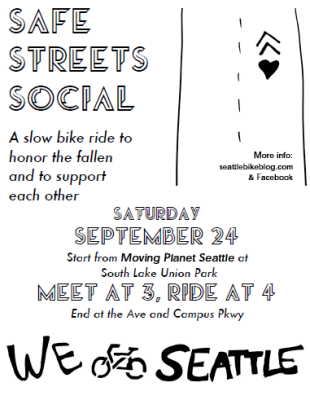 Many bicyclists are doing some soul-searching after the deaths of three cyclists in the past two months in Seattle, a gold-level bicycle-friendly community.
Many bicyclists are doing some soul-searching after the deaths of three cyclists in the past two months in Seattle, a gold-level bicycle-friendly community.
Two of the bicyclists crashed with left-turning motorists; the third fell after missing a turn and going down some sidewalk steps.
Those bicycle riders — Mike Wang, Robert Townsend, and Brian Fairbrother — will be honored at “Safe Streets Social: A slow bike ride to honor the fallen and to support each other.” See Seattle Bike Blog for details. There's also a Facebook event page.
Two others cyclists died in driver collisions in nearby Kirkland and Renton, and a third cyclist was struck from behind and killed in Port Angeles on the Olympic Peninsula.
Six deaths is a lot to bear for a bicycling community that had gone many months without a fatality.
The Cascade Bicycle Club, which represents 14,000 members in the area, and Seattle Mayor Mike McGinn put aside the rhetoric last week in a mature response to the deaths.
Cascade launched a “We Can Do Better” crusade aimed at bicyclists, motorists and pedestrians. Essentially, we need to look out for each other.
The conduct this requires is appropriate everywhere, not just Seattle. Here's what they're saying:
Bicyclists:
- Slow down, and look twice. The minute you’re
shaving off your commute by racing down the trail and blowing traffic
signals can cost a life, possibly your own. - Follow the rules of the road. Be an ambassador of best biking conduct. Be predictable, be visible, and be vigilant. Stop at traffic signals.
- Make eye contact and signal your intent. Drivers want to know what you’re doing. Making eye contact will help you see who isn’t looking for you.
- Look for pedestrians. It is a cyclist’s responsibility to yield to pedestrians.
Drivers:
- Slow down, and look twice. There are vulnerable
users all around you. Look over both shoulders for people crossing the
street and for bicycles alongside. The five seconds you might save by
driving fast or not stopping can cost a life and irrevocably change your
own.
- Be a community pace car. We are in control every
time we get behind the wheel. Observe the speed limit, don’t run red
lights, and come to complete stops at stop signs. Yield to pedestrians.
Expect to see bicycles.
Pedestrians:
- Make eye contact. Pay attention to the environment
around you. Communicate with drivers and bicyclists so your intent is
known. You are the most vulnerable roadway user out there.
Cascade also called for improving infrastructure to improve transit, bicycling and walking conditions.
Meanwhile, Seattle bicycle-commuting mayor announced a traffic summit — not a bicycle summit as reported in some media. Writes McGinn:
“My office will be convening a summit of community leaders, experts and
elected officials to determine how best we can encourage an attitude of
responsibility and empathy on the roads, and make it safer for all
users. Seattle Department of Transportation Director (SDOT) Peter Hahn,
Seattle Police Department (SPD) Chief John Diaz, and several members of
the City Council have already agreed to participate. We’re working on
the details of the summit right now…”
McGinn also says the city also will study ways to improve and expand enforcement of those traffic laws that contribute to most collisions — failure to yield, speeding and impairment. I assume scofflaws on bicycles will be targeted as well:
“And we’ll do so in a way that avoids scapegoating, but that reminds
everyone that they are responsible for protecting each other by
following the rules of the road.”
McGinn also talks about improving infrastructure, and points to next year's updated bicycle master plan as a way to understand where changes are needed.
Meanwhile, Tom Fucoloro, who writes the Seattle Bike Blog, takes up this “We Can Do Better” mantra. However, he says the city already has all the proof it needs and should go ahead with making the streets safer. He writes:
“No more public meetings for projects based on SDOT’s sound traffic
analysis and experience. Every dangerous four lane road in the city that
SDOT deems a viable candidate for a rechannelization based on
experience and analysis should be given the go-ahead. 30 years of
experience and study is sufficient. Waiting for more people to die has
proven to be a devastating strategy.”

Recent Comments